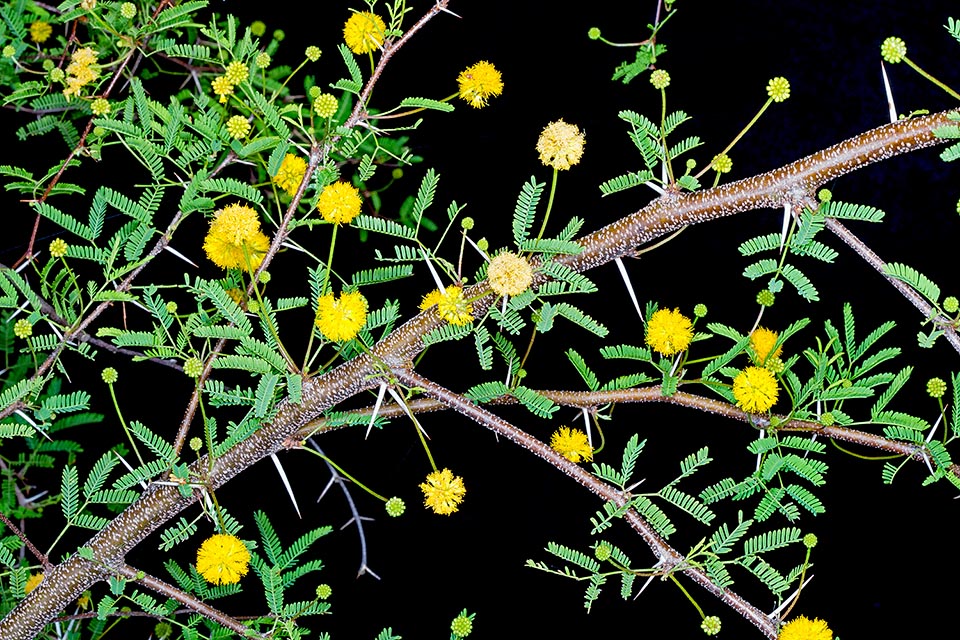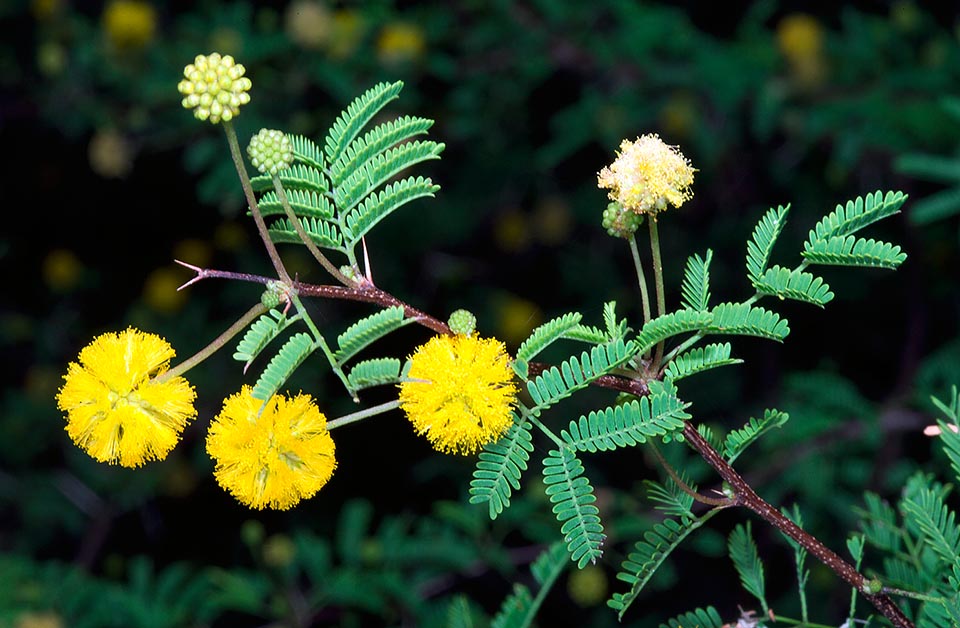Family : Fabaceae

Text © Pietro Puccio

English translation by Mario Beltramini
The species is native to southern Florida (USA) where it lives in the clearings of the coastal thickets or in the underwood of the forests of conifers on mainly rocky-calcareous soils.
The generic term comes from the Greek “ακακία” (akakia), name utilized by Theophrastus and by Dioscorides to indicate a thorny Egyptian tree, probably derived by “ακη” (ake) = thorn, point; the name of the species is the plural genitive of the Latin substantive “pinetum, i” = pine forest, with reference to the habitat where it lives.
Common names: Florida acacia, pine acacia, pineland acacia, pineland wattle (English).
The Acacia pinetorum F.J.Herm. (1948) is a shrub or a small evergreen tree very ramified, up to 4 m tall, but that usually in cultivation does not exceed 1-2 m, with brown reddish lithe trunk and branches, glabrous, armed with stipular spines in couple, straight, 1-3 cm long; like in other Fabaceae, the rooting apparatus is capable to fix the atmospheric nitrogen.

Native to the pinewoods of southern Florida, the Acacia pinetorum is a shrub or a small evergreen tree up to 4 m tall. Very ramified, adapts well to the poor, rocky or sandy soils, provided draining, that enriches as is the case for other leguminous plants, with its rooting apparatus capable to fix the atmospheric nitrogen © Giuseppe Mazza
The leaves, on an about 5 mm long petiole, are alternate, bipinnate, 1-3 cm long, with 3-5 pairs of opposite paripinnate leaflets, each formed by 9-16 pairs of sessile opposite leaflets, contiguous, oblong with entire margin, 1-5-3,5 mm long, of pale green or grey green color, glabrous.
Axillary capitulum inflorescences, on a 2-3 cm long peduncle, globose, of 0,6-1 cm of diameter, formed by a crowd of sessile hermaphroditic flowers arranged very close one with the other, with 5 lobes calyx, 1-5-2 mm long, 5 lobes corolla, 2-2,5 mm long, and numerous stamens of bright yellow color, 4-5 mm long; the flowers emit an intense sweet fragrance.
The fruits are oblong legumes with usually acuminate apex, more or les curved, 3-7,5 cm long and 1-1,5 cm broad, blackish brown, indehiscent, containing 3-10 slightly flattened ovoid seeds, about 4-6 mm long.

Elegant leaves and 6-10 mm globose inflorescences, very perfumed, that light up the eye brightening the wood. A species rich of virtues that well adapts to form fences, bearing the pruning and temperature drops up to about -12 °C. Even if growing not far from the coasts, it does not however tolerate the salty winds © Giuseppe Mazza
It reproduces by seed, semi-woody cutting and air layering. Occasionally cultivated, due to the showy long lasting blooming, in full sun or slightly shade, as protective barrier and, with appropriate pruning, as ground cover or small tree.
Well rooted, it does not need particular cares, stands drought periods and adapts to rocky or sandy poor soils, provided draining, possibly calcareous, resists low temperatures, up to -12 °C, after what related in literature, but not salty winds. The species is the main plant hosting in Florida the butterfly Cyclargus ammon (Lucas, 1857), known also as “Nickerbean Blue”.
Synonyms: Vachellia insularis Small (1933); Vachellia peninsularis Small (1933); Acacia farnesiana subsp. pinetorum (F.J. Herm.) Ebinger & Seigler (2002); Vachellia farnesiana var. pinetorum (F.J. Herm.) Seigler & Ebinger (2005).
→ To appreciate the biodiversity within the family of FABACEAE please click here.
